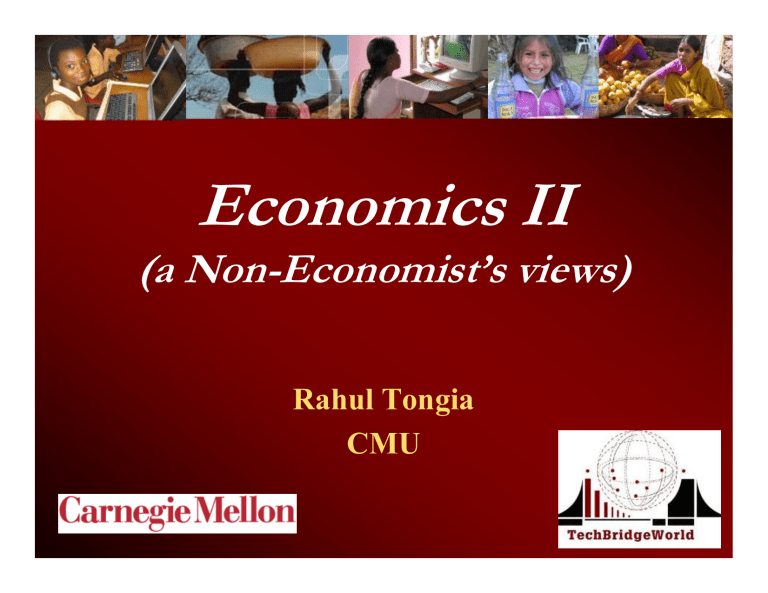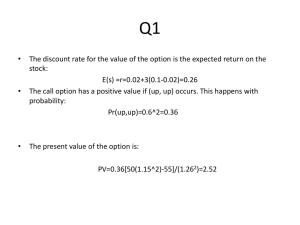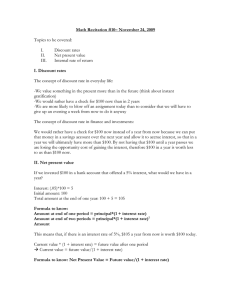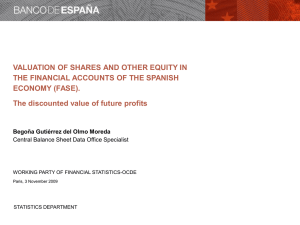Economics II (a Non-Economist’s views) Rahul Tongia CMU

Economics II
(a Non-Economist’s views)
Rahul Tongia
CMU
Microeconomics
Where does it apply?
What are its fundamentals?
What are its components?
Individual, selfish actors
Markets, competition, information
Supply, Demand, Price
(latter signals behavior)
2
What are its limits and shortcomings?
Assumes efficient markets, no externalities, marketclearing prices, etc.
A firm (or individual, microeconomics rational actor) usually deals with
What does a market need?
Perfect information
No barriers to entry o I.e., meaningful competition o What are examples (modes) of barriers to competition?
No externalities
3
Markets are meant to be efficient, not equitable
4
Well Functioning Markets =
Competitive
Leads to efficiency
So, why does an iPod Nano cost $149 or $199? (4 GB and 8 GB, respectively, 9/18/07) o What do you think it costs them to make these?
Aren’t companies/entities not supposed to earn supernormal profits?
o Theory would say no earning profits beyond costs of capital
Successful products need a large ecosystem around them
Conversely, an individual product has its own lifecycle of costs and human impact
5
Bill of Materials – iPod Nano
Direct materials cost estimate of the new iPod nanos (US$)*
Component
Flash memory
Display
Core video processor/microprocessor
Electro mechanicals
SDRAM
Mechanicals
Misc. components battery
Power management IC
Video driver
CODEC
Mixed signal array / Touch wheel controller
Buck regulators
Utility flash memory
Subtotal
$1.38
$0.85
$0.90
$0.65
$0.15
$0.59
$58.85
4GB
$24.00
$10.60
$8.60
$2.44
$2.72
$2.33
$2.25
$1.40
$1.38
$0.85
$0.90
$0.65
$0.15
$0.59
$82.85
8GB
$48.00
$10.60
$8.60
$2.44
$2.72
$2.33
$2.25
$1.40
Source: iSuppli (2007)
6
Costs vs. Prices
They are not the same!!
Profit margins vary o Long-run and short-run marginal costs differ
– Bill of materials (BOM) excludes R&D, software, etc.
– BOM also excludes marketing and other soft costs
Consider WiFi Phones o Isn’t the BOM very low?
o Why hasn’t this become the norm yet?
7
Some other issues with
Economic metrics
Information asymmetry and inaccuracy
Non-monetary transactions o Black economy
Models apply only at the margin (e.g., elasticity) o Under equilibrium conditions o Mean vs. median issues
What am I spending money on?
o Goods versus services (different accounting) o What is hardware vs. software
Time spent on different activities o Himachal Pradesh (India) gives an interesting example
– Schooling vs. gathering wood and water
8
Is Poverty Absolute or
Relative?
What is the Poverty Line?
Which would you rather have?
o A B
– You make $110,000/yr You make $100,000/yr
– Everyone else makes Everyone else makes
$200,000/yr $85,000/yr
(both scenarios in real terms, i.e., exclude inflation)
9
Profits – Good or Bad?
Isn’t this an inherent tension: o Profits vs. affordability?
o Economies of scale or volume could allow both
Profits are a necessary thing o Spur investment, growth, etc.
o We’ll study profits and economic sustainability/viability shortly
10
11
Project (Techno-economic)
Evaluation
If I’m an entrepreneur, how do I know a particular idea is worthwhile?
o Cynical answer – doesn’t matter, just need someone to fund me!
– That is a venture capital worldview (think dot.coms)
– Not true if we’re taking out a loan
– What’s the difference between debt (loans) and equity?
12
Project Valuation
Is this worth it?
What are my alternatives?
Risk-return tradeoff o More risk, higher *expected* return
– Bond ratings o Country risks
– Currency exchange rates
– Nationalization
– Regulation o Large projects involve sophisticated financial instruments, such as options, derivatives, hedges, etc.
Time Value of Money
Discount Rate o Personal, Market, Societal
– Borrowing
≠
Lending rate o Inflation (real vs. nominal) o Opportunity Cost
Cost of Capital o Debt
13 o Equity (“riskier”)
– In the absence of
“distortions” (e.g., taxes), ratio shouldn’t matter – it is the project cash flows that matter
Inflation o Consumer Prices Index
(CPI), Wholesale Price
Index (WPI) Prime
14
Calculations – Project
Valuation
Simplification o Assume ‘r’ is the discount rate o ‘N’ is the number of periods (e.g., years)
– n = 0, 1, 2, …N (n=0 means now)
Time Value of Money o Value final
= Value init x
(1 + r)
∆ n o Leads to compounding effects
Say I borrow $100 @ 5% p.a.
o If I can earn $6/yr from this, is that enough?
What about principal repayment?
15
Repayment of $100 Loan
$120
$100
$80
$60
$40
$20
$0
Life of Loan (Years)
2%
4%
6%
8%
10%
12%
Project Cash Flows
(Raw
Σ
= 105 net)
But: time value of money?
50
0
Net Present Value (NPV) o Convert all future values to present values using chosen rate
‘r’ o Add them up o If NPV > 0, it is a worthwhile project
– Answer depends on the discount rate
-50
-100
-100
-150
-20
Cash Flows Over Time
10
20
35
40 40
30
20 20
10
Time Period
16
17
Internal Rate of Return
(IRR)
Alternative technique to valuation
Defined as that discount rate such that NPV = 0 o Previous example, IRR = 12.3% o Sounds simple
Complexity o Shape of cash flows matters – only useful when cash flows are simple o Can have 2+ IRRs (!) o Best to chose the “appropriate” discount rate and perform
NPV calculations







